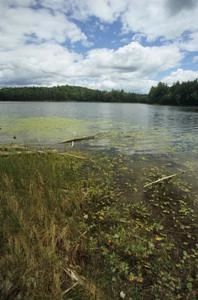Lake Laura Hardwoods
No. 500

Photo by Thomas A. Meyer/DNR
Situated on rolling to broken pitted outwash terrain between Lake Laura and Salsich Lake, Lake Laura Hardwoods features an extensive northern mesic forest that includes old-growth stands as well as mature stands that possess or are developing old-growth attributes. Some stands are over 250 years old. Canopy dominance varies from almost pure hemlock with white pine to pure hardwoods including sugar maple, yellow birch and basswood. Reproduction is primarily sugar maple but balsam fir is an important sapling locally. Hemlock and yellow birch are reproducing well near Salsich Lake.
The understory includes Canada mayflower, lycopods, intermediate wood fern, rough-leaved rice grass and twisted stalk. Where sugar maple is dominant associates include yellow birch, red oak, white ash and basswood with occasional large white pine and hemlock. Common ground layer species include Pennsylvania sedge, wood anemone, hepatica, American starflower, sessile-leaved bellwort and false Solomon's seal. Shrubs present are leatherwood, beaked hazelnut and American fly honeysuckle.
Salsich Lake is a 48-acre soft-water seepage lake, which is ringed with a mature forest. Along the southeast shore is an old-growth hemlock-hardwood stand with a long history of research use by Purdue University and University of Wisconsin ecologist, John Curtis. The lake bottom is mostly sand with some gravel, boulders and silt and supports a rare dragonfly that has only been found in Vilas County. The clear-water lake contains freshwater sponges, indicating high water quality. Animal life is diverse with the bald eagle, broad-winged hawk, common loon, pileated woodpecker, evening grosbeak, blackburnian warbler, ovenbird, northern parula and bobcat. Of note is the presence of lungwort, a lichen that is an indicator of undisturbed ecosystems. Lake Laura Hardwoods is owned by the DNR and was designated a State Natural Area in 2007.
Very few State Natural Areas have public facilities, but nearly all are open for a variety of recreational activities as indicated below. Generally, there are no picnic areas, restrooms, or other developments. Parking lots or designated parking areas are noted on individual SNA pages and maps. If a developed trail is present, it will normally be noted on the SNA map and/or under the Maps tab. A compass and topographic map or a GPS unit are useful tools for exploring larger, isolated SNAs.
The good majority of SNAs are isolated and have few or no facilities. Some SNAs have vehicle access lanes or parking lots, but their accessibility may vary depending on weather conditions. Parking lots and lanes are not plowed during winter. Hiking trails may be nonexistent or consist of undeveloped footpaths. A GPS unit or compass and a detailed topographic map are useful tools for exploring larger SNAs.
Entrance fees: Except for Parfrey's Glen, the Cambrian Outlook in the Dells of the Wisconsin River, SNAs within State Parks and some within State Forests, all other DNR-owned SNAs do not have any admission fees. For more information, see Wis. Admin. Code NR 45 [exit DNR]. For non-DNR-owned SNAs, we are unaware of any vehicle or admission fees. However, please contact the landowner for more information.
Allowable activities: DNR-owned land
The activities listed below are generally allowed on all DNR-owned SNA lands. Exceptions to this list of public uses, such as SNAs closed to hunting, are noted above and posted with signs on the property site.
- Hiking
- Fishing
- Cross country skiing
- Hunting
- Trapping
- Scientific research (permit required [PDF])
- Outdoor education
- Wild edibles (What is this?)
- Pets (Rules)
- Wildlife viewing
Prohibited activities: all SNAs
Although a handful of sites allow activities like primitive camping (e.g. Lower Chippewa River on sand bars) or horseback riding (e.g. S. Kettle Moraine), the activities listed below are generally prohibited on DNR-owned SNAs.
- Camping and campfires
- Collecting of animals (other than legally harvested species), non-edible fungi, rocks, minerals, fossils, archaeological artifacts, soil, downed wood, or any other natural material, alive or dead.
- Collecting for scientific research requires a permit issued by the DNR
- Collecting of plants including seeds, roots or other non-edible parts of herbaceous plants such as wildflowers or grasses
- Drones: Flying-related activities, including the use of drones, hang-gliders and model airplanes, are prohibited. Permission may be issued by the SNA Program for the use of drones for educational or research purposes
- Geocaching
- Horseback riding
- Rock climbing
- Vehicles, including bicycles, ATVs, aircraft, and snowmobiles except on trails and roadways designated for their use.
For rules governing state-owned SNAs and other state lands, please consult Chapter NR 45 Wis. Admin. Code [exit DNR].
Location
Within the Northern Highland-American Legion State Forest, Vilas County. T41N-R8E, Sections 11, 12, 13, 14. 852 acres.
Driving directions
From Star Lake, go east on County Highway K for 2 miles, then north on Deerfoot Road for 0.7 miles to a boat launch. Walk west into the site.
The DNR's state natural areas program is comprised of lands owned by the state, private conservation organizations, municipalities, other governmental agencies, educational institutions and private individuals. While the majority of SNAs are open to the public, access may vary according to individual ownership policies. Public use restrictions may apply due to public safety, or to protect endangered or threatened species or unique natural features. Lands may be temporarily closed due to specific management activities.
Users are encouraged to contact the landowner for more specific details. The data shown on these maps have been obtained from various sources, and are of varying age, reliability, and resolution. The data may contain errors or omissions and should not be interpreted as a legal representation of legal ownership boundaries. To create your custom map where you can zoom to a specific location, please use the DNR's Mapping Application.
Lake Laura Hardwoods is owned by: Wisconsin DNR
